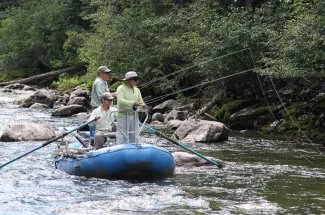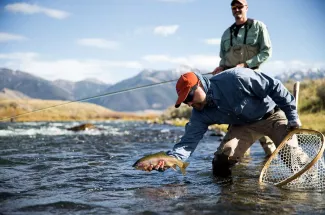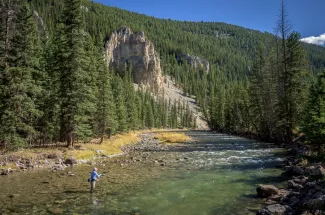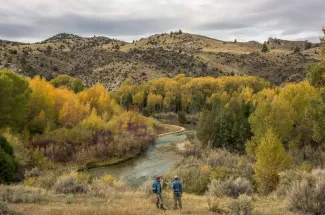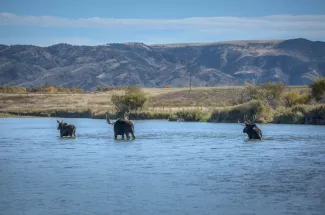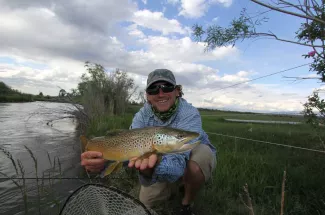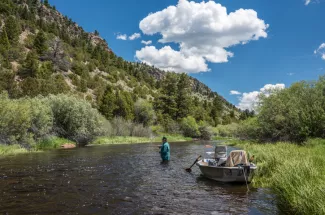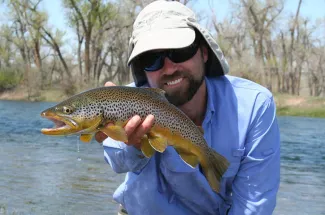Southwestern Montana contains the best concentration of quality trout fisheries in the Lower 48 states. The sheer amount and variety of water is astounding. From large tailwaters to mountain freestones to spring creeks, Southwestern Montana has it all. This is the best part of the state to catch a truly large trout as well, as rivers such as the Yellowstone, Madison, and Big Hole put out fish in the 30" class each season.
Boulder River
This rough and tumble freestone river drains one of the most picturesque valleys in all of Montana. Fishing is good here for both Browns and Rainbows that average in the 12-14 inch range but often go bigger. Wade access is plentiful up in the hills through National Forest land, while the lower end of the valley is mostly private. The river has a short float season early in the summer for those with the gear and skills to take it on.
Madison River
Dubbed the "50 Mile Riffle" for its fast, boulder strewn character, the Madison is one of the worlds great trout fisheries. From its headwaters in Yellowstone Park to its confluence with the Missouri at Three Forks, the Madison boasts over 100 miles of productive and varied trout water. The Salmonfly hatch, which takes place in late June each year, draws anglers from around the country for the chance to stick a truly large trout on a dry fly.
Yellowstone River
The Yellowstone is one of the crown jewels of American rivers. It's nearly 700 mile length is devoid of dams, the longest such river in the Lower 48 States. About 200 miles of that reach, from high in Yellowstone National Park down to the town of Columbus, MT, offers excellent trout fishing. This large river is best fished by boat, and access points for floaters are abundant. Fishing really picks up in April and May with the famous Mothers Day Caddis hatch, with the Salmonfly hatch following after runoff in late June and early July.
Gallatin River
The Gallatin Canyon, where the movie "A River Runs Through It" was filmed, is a grand setting for fly fishing. The clear, cold, swift waters of the Gallatin are home to feisty 'Bows and Browns that are often eager to rise for a dry fly. The vast majority of the river is restricted to wade fishing, and access is both ample and easy. The river is paralleled by road from Bozeman, MT all the way up to the headwater reaches inside of Yellowstone National Park.
Stillwater River
A slightly larger version of the Boulder, the Stillwater is a swift river that flows out of the Beartooth Mountains to meet the Yellowstone. Regular bridge crossings and fishing access sites make the Stillwater an ideal river to float for those with the skills to navigate the rocky rapids. Rainbow Trout are abundant throughout the river, and the dry fly fishing can be quite good for those who can hit the targets quickly and accurately.
Ruby River
Below Ruby Reservoir, the Ruby River is a small, productive tailwater fishery. The population is heavily skewed towards Brown Trout, some of which grow to be quite large. The main issue on the Ruby is access. Much of the river is held in large chunks by wealthy out of state landowners who have waged war in the courts against Montana's stream access law. Fortunately, the courts have consistently sided with anglers and access to the Ruby is available at bridge crossings as well as several state fishing access sites.
Jefferson River
The Jefferson is one of the most overlooked major rivers in Montana. For years, the river was plagued by drought and constant dewatering for irrigation. Fortunately, local ranchers and conservation groups have worked together to keep more water in the river each summer. The trout numbers do not compare to other famous rivers in the area, however, so the Jeff remains free of crowds. The river has always had a reputation for big Brown Trout, and it's a great choice if you want to "swing for the fences". While you can certainly catch a lot of trout over here some days, the Jeff will always be a "quality over quantity" fishery.
Shields River
The Shields is a small tributary of the Yellowstone just east of Livingston, MT. It is home primarily to Yellowstone Cutthroats and Browns, the latter of which can be quite large for such a small stream. The Shields is too small to float, and wading access is limited to one state fishing access site and several county road crossings. During good water years, the Shields stays cool all summer and offers some excellent hopper fishing. Other years can be warm and slow fishing in the dog days of summer, but will quickly pick back up when cool weather hits and the Browns start to become aggressive.
Beaverhead River
This narrow, twisty tailwater is one of Montana's true "fish factories". It is astounding at times how many fish can be found in such a small river. While some wading access is available, the river is best floated due to the extremely brushy banks and deep, swift nature. Nymphing is the mainstay here, although hatches of PMD's and Craneflies, among others, will bring fish to the surface.
Big Hole River
One of Montana's premier freestone streams, the Big Hole's fame is well deserved. The annual Salmonfly hatch each June is one of the most anticipated events on the fishing calendar. The most popular way to fish the Big Hole is to float, and most of this is concentrated on the stretch from Wise River down to Melrose, MT. The Big Hole can be plagued by low, warm water later in the summer, so it's best to hit this piece earlier in the season.
Bighorn River
Like the Missouri, the Bighorn is a large tailwater fishery with an astounding number of trout per mile, up to 7,000 at times. The Bighorn is located much farther east than Montana's other famous trout fisheries, below Yellowtail Dam at the town of Fort Smith, MT. Despite its isolation, the Bighorn attracts anglers from all over the country. The Bighorn is a year-round fishery, and makes a great destination during "off-peak" times of the year.


